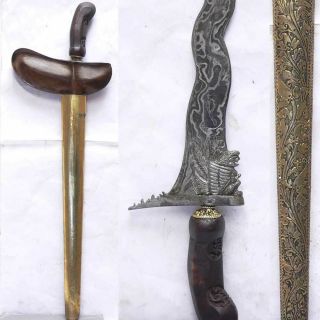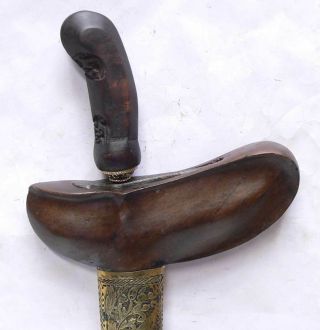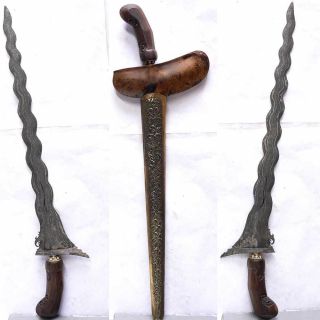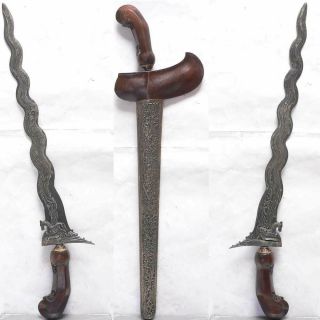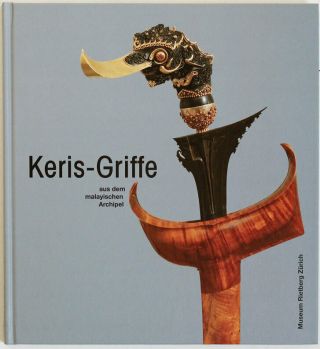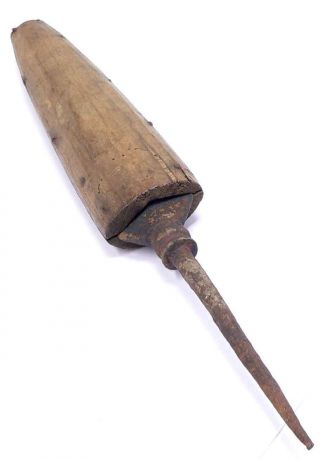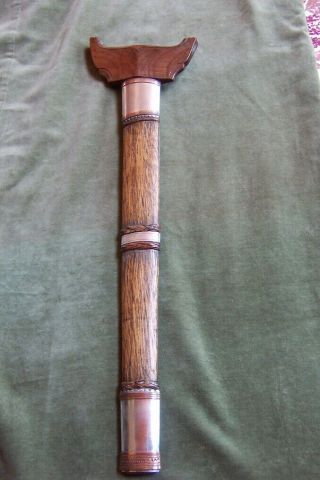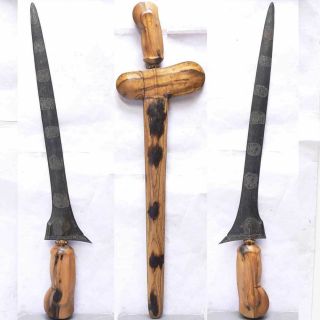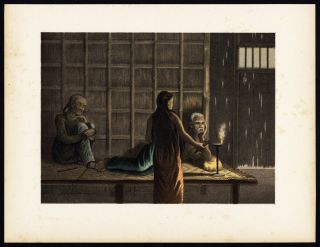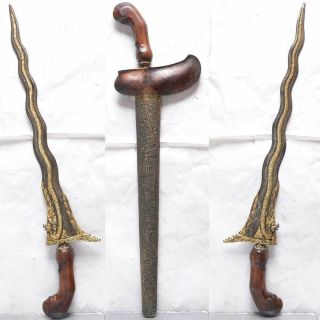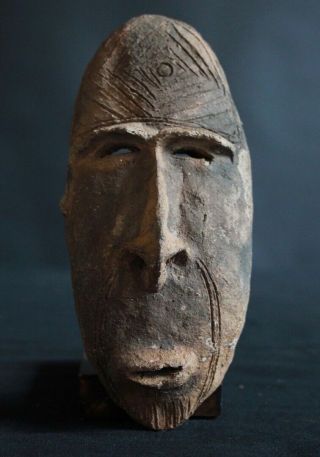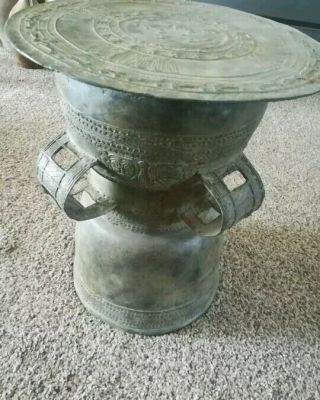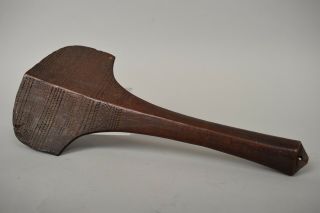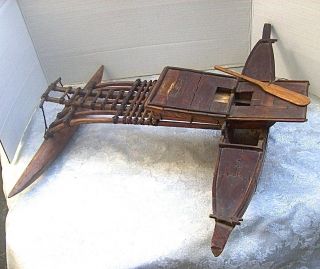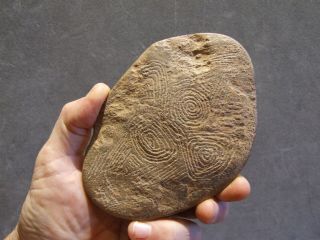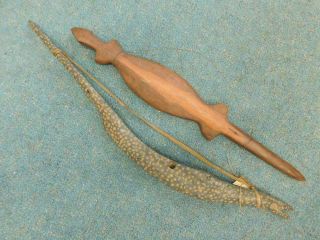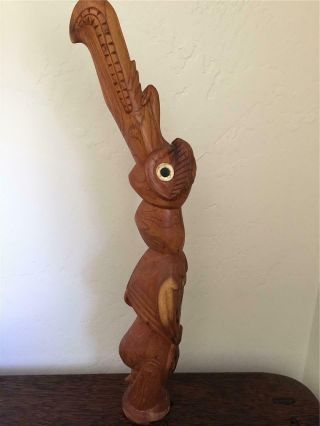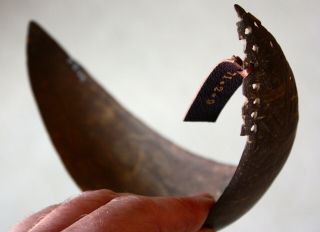KRIS Keris 11 LOKS Java Jogjakarta Indonesia Tribal Art Magic Sword GARUDA BLADE
Item History & Price
| Reference Number: Avaluer:15867719 | Original/Reproduction: Original |
| Country of Origin: Indonesia | Category: Antiques Ethnographic |
| Asian Culture: Indonesia |
Indonesian keris (kris) .
I'm selling a collection of old Indonesia goods, mainly weapons and statues. This one was labelled "11 loks Garuda Kris uit Djogjakarta"
I found on the internet about for 11 luk: ..The keris with eleven luks represents the aims of a person who has huge ambitions. This kind of person strives to attain a higher social status. This explains the fact that the ones who own a keris l...ike this are mostly people who already have a job and/or a family. .....Luk 11 : to achieve high position I found on the internet about for Garuda:..The Garuda (Sanskrit: गरुड Garuḍa; Pāli: गरुळ Garuḷa) is a legendary bird or bird-like creature in Hindu, Buddhist and Jain mythology.[1][2][3] He is variously the vehicle mount (vahana) of the Hindu god Vishnu, a dharma-protector and Astasena in Buddhism, and the Yaksha of the Jain Tirthankara Shantinatha.[2][3][4]Garuda is described as the king of birds and a kite-like figure.[5][6] He is shown either in zoomorphic form (giant bird with partially open wings) or an anthropomorphic form (man with wings and some bird features). Garuda is generally a protector with power to swiftly go anywhere, ever watchful and an enemy of the serpent.[1][6][7] He is also known as Tarkshya and Vynateya.[8]Garuda is a part of state insignia in India, Myanmar, Thailand, Cambodia and Indonesia. The Indonesian official coat of arms is centered on the Garuda. The national emblem of Indonesia is called Garuda Pancasila....
...Indonesia uses the Garuda in a form called the Garuda Pancasila as its national symbol. It is somewhat intertwined with the concept of the Phoenix. The Garuda Pancasila is coloured black or gilded, symbolizing both the greatness of the nation and the elang Jawa (Javan hawk-eagle Nisaetus bartelsi). The black color represents nature. There are 17 feathers on each wing, 8 on the lower tail, 19 on the upper tail and 45 on the neck, which together make up the date 17 August 1945, when Indonesia proclaimed its independence. The shield it carries bears the motto Panca Sila, which symbolizes self-defense and protection in struggle.... ..Garuda mythology is linked to that of Aruna – the charioteer of Surya (The Hindu Sun god). However, these Indian mythologies are different, inconsistent across the texts. Both, Aruna and Garuda, developed from the egg. According to one version, states George Williams, Kashyapa Prajapati's two wives Vinata and Kadru wanted to have children. Kashyapa granted them a boon.[18] Kadru asked for one thousand Nāga sons, while Vinata wanted two, each equal to Kadru's thousand naga sons. Kashyapa blessed them, and then went away to a forest to meditate. Later, Kadru gave birth to one thousand eggs, while Vinata gave birth to two eggs. These incubated for five hundred years, upon which Kadru's eggs broke open and out came her 1, 000 sons. Vinata eager for her sons, impatiently broke one of the eggs from which emerged the partially formed Aruna, who looked radiant and reddish as the morning sun but not as bright as the midday sun.[18][19] Aruna chided his mother, Vinata for her impatience since he was born without legs, warned her to not break open the second egg and cursed her to be a slave until his brother rescues her. Aruna then left to become the charioteer of Surya, the sun god.Vinata waited, and after many years the second egg hatched, and Garuda was born. Her mother loses bet via cheat, to co-wife of her husband and becomes her slave. Garuda later on put request to his brothers, to free her mother from slavery at which they demanded Amrita from heaven. Garuda wages a war against gods and with his extraordinary might and abilities beyond thinking, defeats all of them along with Indra as their head. Bypassing Indra's security he took Nectar vessel and took flight for earth. In the meanwhile Vishnu comes there and asks for a boon to be his ride, which he granted. Indra request him to not give the Amrita to those Nagas as they will trouble them later, at which they forged a plan. Garuda reaching at his brothers placed the vessel before them, and asked them to first purify themselves before drinking. Meanwhile Indra comes there and take the vessel with him. On returning, they were all fed to Gadura. [18][20]Some myths present Garuda as so massive that he can block out the sun.[21] The text Garuda Purana is named after him.[22]Garuda is presented in the Mahabharata mythology as one who eats snake meat, such as the story about him planning to kill and eat Sumukha snake, where Indra intervenes. Garuda in anger, vaunt about his feats and compares himself to Indra's equal. Vishnu teaches lesson to Garuda and cured his pride on might.[23] Garudas are also a race of birds who devour snakes in the epic.[23]The Suparṇākhyāna, a late Vedic period poem considered to be among the "earliest traces of epic poetry in India, " relates the legend of Garuda, and provides the basis for a later, expanded version which appears within the Mahābhārata.[24][25]SymbolisGaruda's links to Vishnu – the Hindu god who fights injustice and destroys evil in his various avatars to preserve dharma, has made him an iconic symbol of king's duty and power, an insignia of royalty or dharma. His eagle-like form is shown either alone or with Vishnu, signifying divine approval of the power of the state.[11] He is found on the faces of many early Hindu kingdom coins with this symbolism, either as a single-headed bird or a three-headed bird that watches all sides.[26]Throughout the Mahabharata, Garuda is invoked as a symbol of impetuous violent force, of speed, and of martial prowess. Powerful warriors advancing rapidly on doomed foes are likened to Garuda swooping down on a serpent. Defeated warriors are like snakes beaten down by Garuda. The Mahabharata character Drona uses a military formation named after Garuda. Krishna even carries the image of Garuda on his banner
I found on the internet about Djogjakarta: Yogyakarta (/ˌdʒɒɡjəˈkɑːrtə, ˌjɒɡ-/;[2] also Jogja or Jogjakarta; Javanese: ꦔꦪꦺꦴꦒꦾꦏꦂꦠ; formerly Dutch: Djokjakarta/Djocjakarta or Djokja) is a city on the island of Java in Indonesia. It is renowned as a centre of education (Kota Pelajar), classical Javanese fine art and culture such as batik, ballet, drama, music, poetry and puppet shows. Yogyakarta is the capital of the Yogyakarta Special Region and was the Indonesian capital during the Indonesian National Revolution from 1945 to 1949, with Gedung Agung as the president's office. One of the districts in Yogyakarta, Kotagede, was the capital of the Mataram Sultanate between 1575 and 1640......HistoryMataram Kingdom (8th – 10th century CE)According to Canggal inscription dated 732, the area traditionally known as "Mataram" became the capital of the Medang Kingdom, identified as Mdang i Bhumi Mataram established by King Sanjaya. The inscription was found (placed in a Hindu temple) in Central Java area, 40 km away from Yogyakarta and 20 km away from Borobudur temple's area. The temple itself was the border between the Hindu dynasty's area and the Buddhist's area (Syailendra dynasty). Mataram became the center of a refined and sophisticated Javanese Hindu-Buddhist culture, for about three centuries its heartland in Kedu Plain (southern slope of Mount Merapi) around Prambanan witnessed the construction of numerous candi including Borobudur and Prambanan. Around the year 929, the centre of the kingdom was shifted to East Java by Mpu Sindok, who established the Isyana Dynasty. The exact cause of the move is still uncertain; however, a severe eruption of Mount Merapi volcano or a power struggle probably caused the move. Historians suggest that, some time during the reign of King Wawa of Mataram (924–929), Merapi volcano erupted and devastated the kingdom's capital in Mataram. Majapahit Empire (1293–1527)During the Majapahit era, the area surrounding modern Yogyakarta was identified again as "Mataram" and recognized as one of the twelve Majapahit provinces in Java ruled by a Duke titled 'Bhre Mataram'. During the reign of Hayam Wuruk (1350 to 1389), the title of Bhre Mataram was held by king's nephew and son in-law Wikramawardhana
….Kotagede (now a district of Yogyakarta) was established as the capital of the Mataram Sultanate. During the reign of Sultan Agung Hanyokrokusumo (1613-1645), the Sultanate Mataram reached its zenith as the greatest kingdom in Java, and expanded its influence to Central Java, East Java and half of West Java. After two changes of capital, (Palace of Pleret and Place of Kerta, both located in Bantul Regency), the capital of Mataram Sultanate moved to Kartasura. Aftermath of the Gianti Treaty (1745–1945
During the reign of Pakubuwono II, a civil war broke out in Mataram Sultanate. The civil war was fought between Prince Mangkubumi and his elder brother, Sunan Pakubuwono II. It started when Sunan Pakubuwono II agreed to cooperate with the VOC, ceded some Mataram territory to the Dutch, and submitted to the foreign power. His younger brother, Prince Mangkubumi stood against the agreement due to concerns that his people would become slaves under Dutch rule. Prince Mangkubumi defeated the Pakubuwono forces and declared sovereignty in the Kingdom of Yogyakarta occupying the southern parts of the former Mataram Sultanate. The Yogyakarta Sultanate was established as a result of the Treaty of Giyanti (Perjanjian Gianti) by Prince Mangkubumi, who later ascended the throne as Sultan Hamengkubuwono I. Officially, the creation of Yogyakarta Sultanate is dated at 7 October 1756 as a result of civil war among the princes of The Mataram Sultanate. This civil war marked the end of the Mataram Sultanate and resulted in the birth of the Yogyakarta Sultanate and the Surakarta Sunanate. During the British occupation of Java, rumors of plans by the Javanese court to stage a rebellion caused uneasiness among the colonial authorities. On 20 June 1812, Stamford Raffles led a 1, 200-strong British force to attack the royal city. The Javanese were surprised by the attack and were easily subdued. In one day the city of Yogyakarta fell, with the city destroyed and its palace looted. The event completely stripped the sultanate of its remaining power and influence.[6] The sack also left the court humiliated and fueled a rebellion which would be known as Java War. Republic of Indonesia era (1945–present)In 1942 the Japanese Empire invaded Dutch East Indies and ruled Java until they were defeated in 1945. Sukarno proclaimed the independence of the Indonesian Republic on August 1945. Sultan Hamengkubuwono IX promptly sent a letter to Sukarno, expressing his support for the newly born nation of Indonesia and acknowledging the Yogyakarta Sultanate as part of the Indonesian Republic. The Sultanate of Surakarta did the same, and both of the Javanese kingdoms were awarded special status as "Special Regions" within the Indonesian Republic. However, because of a leftist anti-royalist uprising in Surakarta, the Sunanate of Surakarta lost its special administrative status in 1946 and was absorbed into Central Java Province. Yogyakarta's support was essential in the Indonesian struggle for independence during the Indonesian National Revolution (1945-1949). The city of Yogyakarta became the capital of the Indonesian Republic from 1946 to 1948, after the fall of Jakarta to the Dutch. Later the Dutch also invaded Yogyakarta, causing the Republic's capital to be transferred once again, to Bukittinggi in West Sumatra on 19 December 1948. Because of its significant contribution to the survival of the Indonesian Republic, Yogyakarta was given the status of Special Administrative Region, making Yogyakarta the only region headed by a monarchy in Indonesia..
and because of the Javanese court Kraton culture of Kraton Yogyakarta, Yogyakarta hosts a sizable tourist industry: The Kraton of Yogyakarta (Bahasa Indonesia: Keraton Ngayogyakarta Hadiningrat, Javanese:ꦏꦿꦠꦺꦴꦤ꧀ꦔꦪꦺꦴꦒꦾꦏꦂꦠꦲꦢꦶꦤꦶꦔꦿꦠ꧀) is a palace complex located in the city of Yogyakarta, Yogyakarta Special Region, Indonesia. It is the official seat of the reigning Sultan of Yogyakarta and his family. It also serves as a center of Javanese culture, and contains a museum displaying artefacts of princely provenance. It is guarded by the Yogyakarta Kraton Guards (Indonesian: Prajurit Keraton Ngayogyakarta Hadiningrat...Kraton means the place where the Ratu (in English: Queen, in Javanese also means: King) resides. The word Keraton (Keraton is living quarter of the royal family in the palace) (shortened form of ratu/Ka-ratuan) derived from the word Ratu, which in Malay means king. The palace was built according to Javanese Philosophy and is shrouded by mysticism. The spatial arrangement of the palace, including the cityscape of the old city of Yogyakarta, including its architecture, direction of buildings, and objects all belongs to the mythological value and belief system of the Javanese. The main street of the old city forms a straight line from Tugu Yogyakarta, Kraton, Mount Merapi to Krapyak Hunting House. The layout mean "the origin of human beings and their last purposes" (Javanese: sangkan paraning dumadi).[1] The road from Krapyak Hunting House to the palace symbolizes the first creation of men stage to adulthood. The villages surrounding Krapyak Hunting House are named mijen from the word wiji (seed). Along the way, Tamarind and Spanish cherry trees are planted to represent the journey from childhood to adulthood. It then goes to Tugu Yogyakarta and finally ends at the palace, meaning the end of human life and meeting the creator. And finally the seven gates of Gladhag to Donopratopo means the seven step to heaven.[1] Tugu Yogyakarta (Gilig golong monument) located on the north side of the old city is a symbol of "unification between the king (golong) and the people (gilig)" (Javanese: manunggaling kawulo gusti). It also symbolizes the final unity of the creator (Khalik) and his subjects. Gate Donopratoro (Gate to Kedaton quarter) means "a good person is someone who is generous and knows how to control his lust" and the two Dwarapala statues, named Balabuta and Cinkarabala, each represent good and evil. The palace's magical artifacts are believed to have the power to repulse evil intention
****
This kris has a nice scabbard with beautiful decorated oversheath, wooden handle and decoration ring.
This kris is in total 49cm. The length of the blade only: 38cm.
00037




